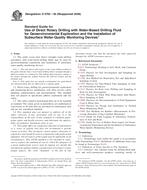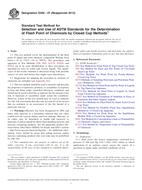Click here to purchase
This standard covers procedures for obtaining laboratory data concerning the toxicity of test material (for example, sediment or hydric soil (that is, a soil that is saturated, flooded, or ponded long enough during the growing season to develop anaerobic (oxygen-lacking) conditions that favor the growth and regeneration of hydrophytic vegetation)) to amphibians. This test procedure uses larvae of the northern leopard frog (Rana pipiens). Other anuran species (for example, the green frog (Rana clamitans), the wood frog (Rana sylvatica), the American toad (Bufo americanus)) may be used if sufficient data on handling, feeding, and sensitivity are available. Test material may be sediments or hydric soil collected from the field or spiked with compounds in the laboratory.
1.2 The test procedure describes a 10-d whole sediment toxicity test with an assessment of mortality and selected sublethal endpoints (that is, body width, body length). The toxicity tests are conducted in 300 to 500-mL chambers containing 100 mL of sediment and 175 mL of overlying water. Overlying water is renewed daily and larval amphibians are fed during the toxicity test once they reach Gosner stage 25 (operculum closure over gills). The test procedure is designed to assess freshwater sediments, however, R. pipiens can tolerate mildly saline water (not exceeding about 2500 mg Cl-/L, equivalent to a salinity of about 4.1 when Na+ is the cation) in 10-d tests, although such tests should always include a concurrent freshwater control. Alternative test durations and sublethal endpoints may be considered based on site-specific needs. Statistical evaluations are conducted to determine whether test materials are significantly more toxic than the laboratory control sediment or a field-collected reference sample(s).
Product Details
- Published:
- 03/01/2013
- Number of Pages:
- 18
- File Size:
- 1 file , 220 KB


